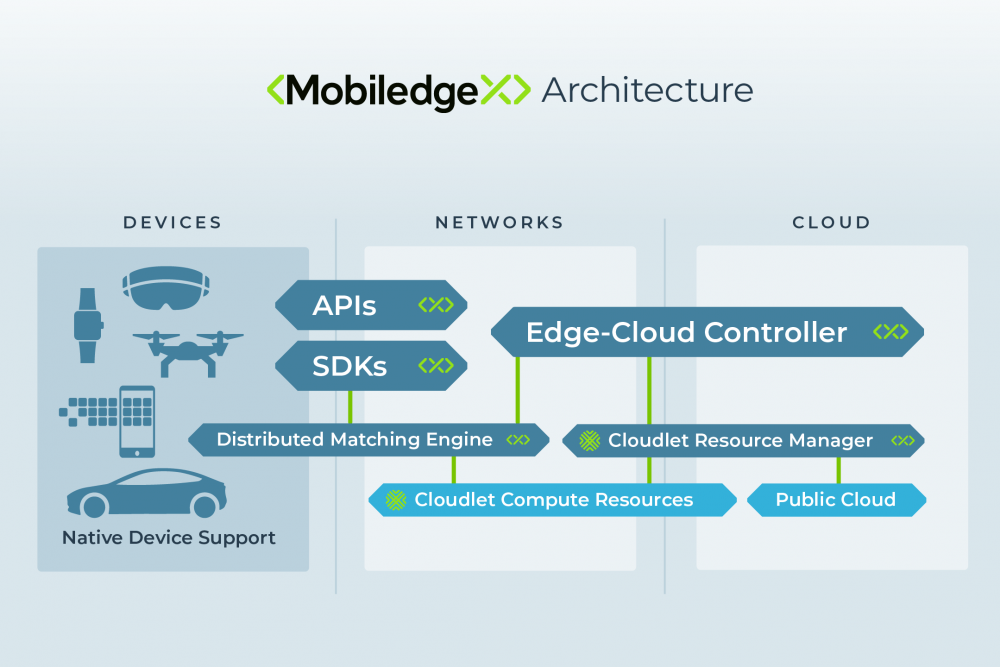The edge computing company founded by Deutsche Telekom, MobiledgeX, is now live with its first public edge network that aggregates existing network operator resources — from parent DT — to host application cloud containers.
Telekom Deutschland CTO Walter Goldenits called the news “an important moment not just for Deutsche Telekom and MobiledgeX, but the broader mobile ecosystem eager to capitalize on the massive edge opportunity in the lead-up to 5G.”
MobiledgeX is already supporting prototyping of developer use cases in public networks, the company said, including applications such as automatic deployment of app back-ends to users, based on verified location and identity, for multi-player gaming or robotics; lower latency and compute capabilities for augmented and mixed reality performance; and video and image processing that meets country-specific rules on privacy regulations.
DT gave the company access to infrastructure in six sites in Germany, according to MobiledgeX CTO Sunay Tripathi, and those are currently operational.
“We are deploying live applications and testing live applications,” Tripathi said.
He said that reflected in the announcement is the fact that people interact with their phones for hours a day and often are interacting with video and natural language, versus typing on a keyboard; and they are fully mobile, not in a fixed location. Often, he added, this occurs in groups — such as groups of people in a multi-player game, groups of vehicles platooning, groups of drones or groups of robots mapping a factory floor, or groups of factory employees all utilizing something like a HoloLens for augmented reality.
“It requires a lot of processing and compute, and putting all that data into the public cloud to get processed there, and then getting the results back, is not viable,” Tripathi said. “That’s where we started focusing.”
In those type of scenarios, he said, “all the things need the same set of KPIs, based on a bunch of people in a similar location. … We need to know who they are, their locations, and we need to deal with a lot of video from simultaneous sources and create a mixed reality based on that processing,” he explained.
The cloud, Tripathi said, has historically been very static on the client side and dominated by long-term arrangements for computing resources. MobiledgeX wants to “bring that cloud closer to where the users are and based on demand,” he said. “We need to dynamically bring the application closer to the user, on-demand, for the duration when needed,” he said. Being integrated with a network operator “comes in very handy. We know where the users are, so we can place the workload closer to the users without violating any privacy — that ends up being one of the core features that we offer from the 1.0 release,” he added.
The other thing MobiledgeX realized, Tripathi said, is that developers often don’t understand infrastructure and are very separated from it — so, he said, “we needed to work on preserving the workflow of developers today, how they develop in the public cloud and deploy. It’s the job of our control plane to take that to a distributed system, on-demand, as needed,” he said. “We go and take that container all the way to the users, on-demand, without the developer going any intervention, basically,” he said.
Asked what would be the tipping point for the edge market, Tripathi said that would be if a game company that utilizes edge computing — such as MobiledgeX customer Niantic, which created Pokémon Go and is working on a new game called Harry Potter: Wizards Unite, which is expected to be released this year — sees success with users simply downloading a game onto their devices, playing and having a much richer, low-latency experience which takes company revenue from single-digit billions into tens of billions — “and it was all served from the edge without [users] knowing about it.”
“The moment you see somebody making millions in revenue, even in one area, because they’d ‘edge-ified’ — you’ll see everyone running after edge at that point,” he said.
Goldenits also addressed the topic of monetization for operators in edge.
“For operators, Edge-Cloud R1.0’s ability to quickly aggregate existing 4G and 5G resources and make them available anywhere they are needed across the network means an extremely low barrier to entry for scalable edge deployments that can be immediately monetized,” Goldenits said in a statement. “When edge networks are deployed widely, developers and device makers can more easily define business and use cases for new offerings that can be rolled out across a large number of users.”


